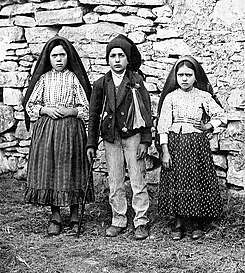Mary, mother of Jesus
Mary[lower-alpha 3] was a first-century Galilean Jewish[2] woman of Nazareth, the wife of Joseph, and the mother of Jesus, according to the canonical gospels and the Quran.[3]
Mary | |
|---|---|
מרים | |
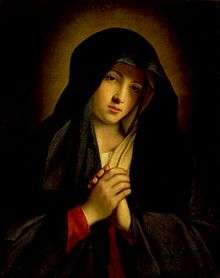 The Madonna in Sorrow, by Giovanni Battista Salvi da Sassoferrato, 17th century. | |
| Born | Date unknown; traditionally celebrated 8 September (Nativity of Mary) c. 18 BC[1] |
| Died | Unknown, after c. 30 / 33 AD |
| Home town | |
| Spouse(s) | Joseph |
| Children | Jesus,[lower-alpha 1] possibly the brothers and sisters of Jesus. |
| Parent(s) | unknown; according to some apocryphal writings: Joachim and Anne[lower-alpha 2] |
| A series of articles on |
| Mother of Jesus |
| Chronology |
|---|
|
|
| Marian perspectives |
|
| Catholic Mariology |
|
|
| Marian dogmas |
|
|
| Mary in culture |
|
|
| Part of a series on |
| Christianity |
|---|
 |
|
|
|
|
|
The gospels of Matthew and Luke in the New Testament and the Quran describe Mary as a virgin.[4] In Matthew and Luke she is betrothed to Joseph.[5] According to Christian theology she conceived Jesus through the Holy Spirit while still a virgin. She accompanied Joseph to Bethlehem, where Jesus was born.[6]
According to Catholic and Eastern Christian teachings, at the end of her earthly life God raised her body directly into heaven; this is known in the Christian West as the Assumption.[7][8]
Mary has been venerated since early Christianity,[9][10] and is considered by millions to be the most meritorious saint of the religion. She is said to have miraculously appeared to believers many times over the centuries. The Eastern and Oriental Orthodox, Catholic, Anglican, and Lutheran churches believe that Mary, as mother of Jesus, is the Theotokos (Mother of God) (Greek: Θεοτόκος, romanized: Theotokos, lit. 'God-bearer'). There is significant diversity in the Marian beliefs and devotional practices of major Christian traditions. The Catholic Church holds distinctive Marian dogmas, namely her status as the Mother of God, her Immaculate Conception, her perpetual virginity, and her Assumption into heaven.[11] Many Protestants minimize Mary's role within Christianity, basing their argument on the lack of biblical support for any beliefs other than the virgin birth (actually a virginal conception).[12] Mary also has the highest position in Islam among all women.[13][14][15] She is mentioned in the Quran more often than in the New Testament,[16] where two of the longer chapters of the Quran are devoted to her and her family.[17]
Names and titles
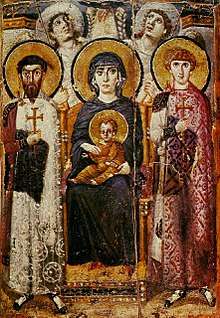
Mary's name in the original manuscripts of the New Testament was based on her original Aramaic name מרים, translit. Maryam or Mariam.[18] The English name Mary comes from the Greek Μαρία, which is a shortened form of Μαριάμ. Both Μαρία and Μαριάμ appear in the New Testament.
In Christianity
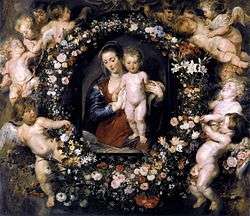
Christians commonly refer to her as the Virgin Mary, in accordance with the belief that the Holy Spirit impregnated her, thereby conceiving her first-born Jesus miraculously, without sexual relations with her betrothed/husband, "until her son [Jesus] was born". (Mt 1:25)[19] The word "until" has inspired considerable analysis on the subject of Mary and Joseph producing siblings after the birth of Jesus; see e.g. Sabine R. Huebner's succinct analysis of the issue.[20] Among her many other names and titles are the Blessed Virgin Mary (often abbreviated to "BVM", or "BMV" after the Latin "Beata Maria Virgo"),[21] Saint Mary (occasionally), the Mother of God (primarily in Western Christianity), the Theotokos (primarily in Eastern Christianity), Our Lady (Medieval Italian: Madonna), and Queen of Heaven (Latin: Regina caeli),[22][23] although the title queen of heaven was for centuries before an epithet for several ancient sky-goddesses — Nin-anna, Astarte, Ishtar et al. — including Astoreth, the Canaanite sky-goddess worshipped during the Hebrew prophet Jeremiah's lifetime.[24] Titles in use vary among Anglicans, Lutherans, Catholics, Orthodox, Protestants, Mormons, and other Christians.
The three main titles for Mary used by the Orthodox are Theotokos (Greek: Θεοτόκος, lit. 'God-bearer' or loosely "Mother of God"), Aeiparthenos (Greek: ἀειπαρθὲνος, lit. 'Ever-virgin') as confirmed in the Second Council of Constantinople in 553, and Panagia (Greek: Παναγία, lit. 'All-holy').[25] Catholics use a wide variety of titles for Mary, and these titles have in turn given rise to many artistic depictions. For example, the title Our Lady of Sorrows has inspired such masterpieces as Michelangelo's Pietà.[26]
The title Theotokos was recognized at the Council of Ephesus in 431. The direct equivalents of title in Latin are Deipara and Dei Genetrix, although the phrase is more often loosely translated into Latin as Mater Dei (Mother of God), with similar patterns for other languages used in the Latin Church. However, this same phrase in Greek (Μήτηρ Θεοῦ), in the abbreviated form ΜΡ ΘΥ, is an indication commonly attached to her image in Byzantine icons. The Council stated that the Church Fathers "did not hesitate to speak of the holy Virgin as the Mother of God".[27][28][29]
Some Marian titles have a direct scriptural basis. For instance, the title "Queen Mother" has been given to Mary since she was the mother of Jesus, who was sometimes referred to as the "King of Kings" due to his ancestral descent from King David.[30][31][32][33][34][35] Other titles have arisen from reported miracles, special appeals, or occasions for calling on Mary. To give a few examples, Our Lady of Good Counsel, Our Lady of Navigators, and Our Lady Undoer of Knots fit this description.[36][37][38][39]
In Islam
In Islam, she is known as Maryam (Arabic: مريم, romanized: Maryām), mother of Isa (Arabic: عيسى بن مريم, romanized: ʿĪsā ibn Maryām, lit. 'Jesus, son of Mary'). She is often referred to by the honorific title sayyidatuna, meaning "our lady"; this title is in parallel to sayyiduna ("our lord"), used for the prophets.[40] A related term of endearment is Siddiqah,[41] meaning "she who confirms the truth" and "she who believes sincerely completely". Another title for Mary is Qānitah, which signifies both constant submission to God and absorption in prayer and invocation in Islam.[42] She is also called "Tahira", meaning "one who has been purified" and representing her status as one of two humans in creation (and the only woman) to not be touched by Satan at any point.[43]
New Testament
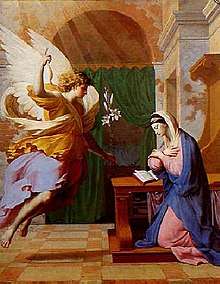
- The Gospel of Luke mentions Mary the most often, identifying her by name twelve times, all of these in the infancy narrative (1:27,30,34,38,39,41,46,56; 2:5,16,19,34).
- The Gospel of Matthew mentions her by name six times, five of these (1:16,18,20; 2:11) {{|This is only 4|}} in the infancy narrative and only once (13:55) outside the infancy narrative.
- The Gospel of Mark names her once (6:3) and mentions her as Jesus' mother without naming her in 3:31 and 3:32.
- The Gospel of John refers to her twice but never mentions her by name. Described as Jesus' mother, she makes two appearances. She is first seen at the wedding at Cana. [Jn 2:1-12] The second reference, listed only in this gospel, has her standing near the cross of Jesus together with Mary Magdalene, Mary of Clopas (or Cleophas), and her own sister (possibly the same as Mary of Clopas; the wording is semantically ambiguous), along with the "disciple whom Jesus loved".[Jn 19:25-26] John 2:1-12 is the only text in the canonical gospels in which the adult Jesus has a conversation with Mary. He does not address her as "Mother" but as "Woman". In Koine Greek (the language that John's Gospel was composed in), calling one's mother "Woman" was not disrespectful, and could even be tender.[44] Accordingly, some versions of the Bible translate it as "Dear woman". (John 2:4 NLT; NCV; AMP; NIV).
- In the Acts of the Apostles, Mary and the brothers of Jesus are mentioned in the company of the Eleven (apostles) who are gathered in the upper room after the Ascension of Jesus.[Acts 1:14]
- In the Revelation to John,[12:1,5-6] Mary is never explicitly identified as the "woman clothed with the sun". Jean-Pierre Ruiz makes that connection in an article in New Theology Review[45] but the belief is quite ancient, as is the association of Mary and the Ark of the Covenant, mentioned at [Revelation 11:19].[46]
Genealogy
The New Testament tells little of Mary's early history. The Gospel of Matthew does give a genealogy for Jesus by his father's paternal line, only identifying Mary as the wife of Joseph. John 19:25 states that Mary had a sister; semantically it is unclear if this sister is the same as Mary of Clopas, or if she is left unnamed. Jerome identifies Mary of Clopas as the sister of Mary, mother of Jesus.[47] According to the early second-century historian Hegesippus, Mary of Clopas was likely Mary's sister-in-law, understanding Clopas (Cleophas) to have been Joseph's brother.[48]
According to the writer of Luke, Mary was a relative of Elizabeth, wife of the priest Zechariah of the priestly division of Abijah, who was herself part of the lineage of Aaron and so of the tribe of Levi. (Luke 1 [Luke 1:5;1:36]) Some of those who consider that the relationship with Elizabeth was on the maternal side, consider that Mary, like Joseph, to whom she was betrothed, was of the royal House of David and so of the Tribe of Judah, and that the genealogy of Jesus presented in Luke 3 from Nathan, third son of David and Bathsheba, is in fact the genealogy of Mary, while the genealogy from Solomon given in Matthew 1 is that of Joseph.[49][50][51] (Aaron's wife Elisheba was of the tribe of Judah, so all their descendants are from both Levi and Judah.)[Num.1:7 & Ex.6:23]
Annunciation

Mary resided in "her own house"[Lk.1:56] in Nazareth in Galilee, possibly with her parents, and during her betrothal—the first stage of a Jewish marriage—the angel Gabriel announced to her that she was to be the mother of the promised Messiah by conceiving him through the Holy Spirit, and, after initially expressing incredulity at the announcement, she responded, "I am the handmaid of the Lord. Let it be done unto me according to your word."[52] Joseph planned to quietly divorce her, but was told her conception was by the Holy Spirit in a dream by "an angel of the Lord"; the angel told him to not hesitate to take her as his wife, which Joseph did, thereby formally completing the wedding rites.[53][Mt 1:18-25]
Since the angel Gabriel had told Mary that Elizabeth—having previously been barren—was then miraculously pregnant,[54] Mary hurried to see Elizabeth, who was living with her husband Zechariah in "Hebron, in the hill country of Judah".[55] Mary arrived at the house and greeted Elizabeth who called Mary "the mother of my Lord", and Mary spoke the words of praise that later became known as the Magnificat from her first word in the Latin version.[Luke 1:46-55] After about three months, Mary returned to her own house.[Lk 1:56-57]
Birth of Jesus

According to the author of the gospel according to Luke, a decree of the Roman Emperor Augustus required that Joseph return to his hometown of Bethlehem to register for a Roman census; see Census of Quirinius.[56] While he was there with Mary, she gave birth to Jesus; but because there was no place for them in the inn, she used a manger as a cradle.[57]:p.14 [2:1ff] After eight days, he was circumcised according to Jewish law and named "Jesus" (Hebrew: ישוע, romanized: Yeshua), which means "Yahweh is salvation".[58]
After Mary continued in the "blood of her purifying" another 33 days, for a total of 40 days, she brought her burnt offering and sin offering to the Temple in Jerusalem,[Luke 2:22] so the priest could make atonement for her.[Leviticus 12:1-8] They also presented Jesus – "As it is written in the law of the Lord, Every male that openeth the womb shall be called holy to the Lord" (Luke 2:23other verses). After the prophecies of Simeon and the prophetess Anna in Luke 2:25-38, the family "returned into Galilee, to their own city Nazareth".[Luke 2:39]
According to the author of the gospel according to Matthew, the Magi arrived at Bethlehem where Jesus and his family were living. Joseph was warned in a dream that King Herod wanted to murder the infant, and the family fled by night to Egypt and stayed there for some time. After Herod's death in 4 BC, they returned to Nazareth in Galilee, rather than Bethlehem, because Herod's son Archelaus was ruler of Judaea.[Mat.2]
Mary is involved in the only event in Jesus' adolescent life that is recorded in the New Testament. At the age of twelve, Jesus, having become separated from his parents on their return journey from the Passover celebration in Jerusalem, was found in the Temple among the religious teachers.[59]:p.210 [Lk 2:41-52]
In the life of Jesus

Mary was present when, at her suggestion, Jesus worked his first miracle during a wedding at Cana by turning water into wine.[Jn 2:1-11] Subsequently, there are events when Mary is present along with James, Joseph, Simon, and Judas, called Jesus' brothers, and unnamed sisters.[60] Following Jerome, the Church Fathers interpreted the words translated as "brother" and "sister" as referring to close relatives.[61][62]
The hagiography of Mary and the Holy Family can be contrasted with other material in the Gospels. These references include an incident which can be interpreted as Jesus rejecting his family in the New Testament: "And his mother and his brothers arrived, and standing outside, they sent in a message asking for him ... And looking at those who sat in a circle around him, Jesus said, 'These are my mother and my brothers. Whoever does the will of God is my brother, and sister, and mother'."[63][3:31-35]
Mary is also depicted as being present among the women at the crucifixion during the crucifixion standing near "the disciple whom Jesus loved" along with Mary of Clopas and Mary Magdalene,[Jn 19:25-26] to which list Matthew 27:56 adds "the mother of the sons of Zebedee", presumably the Salome mentioned in Mark 15:40. This representation is called a Stabat Mater.[64][65] While not recorded in the Gospel accounts, Mary cradling the dead body of her son is a common motif in art, called a "pietà" or "pity".
After the Ascension of Jesus
In Acts 1:26, especially v. 14, Mary is the only one other than the eleven apostles to be mentioned by name who abode in the upper room, when they returned from Mount Olivet. Some speculate that the "elect lady" mentioned in 2 John 1:1 may be Mary. From this time, she disappears from the biblical accounts, although it is held by Catholics that she is again portrayed as the heavenly woman of Revelation.[Rev 12:1]
Her death is not recorded in the scriptures, but Catholic and Orthodox tradition and doctrine have her assumed (taken bodily) into Heaven. Belief in the corporeal assumption of Mary is a dogma of the Catholic Church, in the Latin and Eastern Catholic Churches alike, and is believed as well by the Eastern Orthodox Church,[66][67] the Coptic Orthodox Church, and parts of the Anglican Communion and Continuing Anglican movement.[68]
Later Christian writings and traditions
According to the apocryphal Gospel of James, Mary was the daughter of Saint Joachim and Saint Anne. Before Mary's conception, Anne had been barren and was far advanced in years. Mary was given to service as a consecrated virgin in the Temple in Jerusalem when she was three years old, much like Hannah took Samuel to the Tabernacle as recorded in the Old Testament.[69]
Some apocryphal accounts state that at the time of her betrothal to Joseph, Mary was 12–14 years old.[70] According to ancient Jewish custom, Mary could have been betrothed at about 12.[71] Hyppolitus of Thebes says that Mary lived for 11 years after the death of her son Jesus, dying in 41 AD.[72]
The earliest extant biographical writing on Mary is Life of the Virgin attributed to the 7th-century saint, Maximus the Confessor, which portrays her as a key element of the early Christian Church after the death of Jesus.[73][74][75]
In the 19th century, a house near Ephesus in Turkey was found, based on the visions of Anne Catherine Emmerich, an Augustinian nun in Germany.[76][77] It has since been visited as the House of the Virgin Mary by Roman Catholic pilgrims who consider it the place where Mary lived until her assumption.[78][79][80][81] The Gospel of John states that Mary went to live with the Disciple whom Jesus loved,[Jn 19:27] identified as John the Evangelist.[Jn 21:20-24] Irenaeus and Eusebius of Caesarea wrote in their histories that John later went to Ephesus, which may provide the basis for the early belief that Mary also lived in Ephesus with John.[82][83]
Perspectives on Mary
Blessed Virgin Mary | |
|---|---|
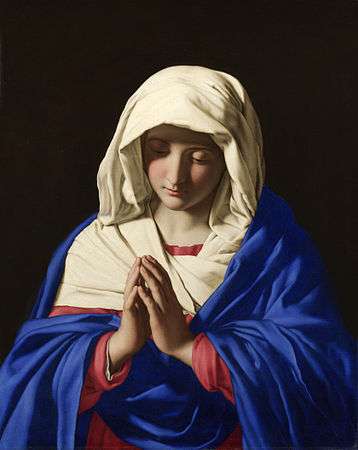 The Virgin in Prayer, by Sassoferrato, c. 1650 | |
| Western Christianity: Mother of God, Queen of Heaven, Mother of the Church (see Titles of Mary) Eastern Christianity: Theotokos Islam: Sayyidatna ("Our Lady"), Greatest Woman, the Chosen One, the Purified One | |
| Honored in | Christianity, Islam |
| Canonized | Pre-Congregation |
| Major shrine | Santa Maria Maggiore (See Marian shrines) |
| Feast | See Marian feast days |
| Attributes | Blue mantle, crown of 12 stars, pregnant woman, roses, woman with child, woman trampling serpent, crescent moon, woman clothed with the sun, heart pierced by sword, rosary beads |
| Patronage | See Patronage of the Blessed Virgin Mary |
Christian

Christian Marian perspectives include a great deal of diversity. While some Christians such as Catholics and Eastern Orthodox have well established Marian traditions, Protestants at large pay scant attention to Mariological themes. Catholic, Eastern Orthodox, Oriental Orthodox, Anglican, and Lutherans venerate the Virgin Mary. This veneration especially takes the form of prayer for intercession with her Son, Jesus Christ. Additionally it includes composing poems and songs in Mary's honor, painting icons or carving statues of her, and conferring titles on Mary that reflect her position among the saints.[23][25][26][84]
Catholic
In the Catholic Church, Mary is accorded the title "Blessed" (Latin: beata, Greek: μακάρια, romanized: makaria) in recognition of her assumption to Heaven and her capacity to intercede on behalf of those who pray to her. There is a difference between the usage of the term "blessed" as pertaining to Mary and its usage as pertaining to a beatified person. "Blessed" as a Marian title refers to her exalted state as being the greatest among the saints; for a person who has been declared beatified, on the other hand, "blessed" simply indicates that they may be venerated despite not being officially canonized. Catholic teachings make clear that Mary is not considered divine and prayers to her are not answered by her, but rather by God through her intercession.[85] The four Catholic dogmas regarding Mary are: her status as Theotokos, or Mother of God; her perpetual virginity; her Immaculate Conception; and her bodily Assumption into heaven.[86][87][88]
The Blessed Virgin Mary, the mother of Jesus has a more central role in Roman Catholic teachings and beliefs than in any other major Christian group. Not only do Roman Catholics have more theological doctrines and teachings that relate to Mary, but they have more festivals, prayers, devotional, and venerative practices than any other group.[26] The Catechism of the Catholic Church states: "The Church's devotion to the Blessed Virgin is intrinsic to Christian worship."[89]
For centuries, Catholics have performed acts of consecration and entrustment to Mary at personal, societal and regional levels. These acts may be directed to the Virgin herself, to the Immaculate Heart of Mary and to the Immaculate Conception. In Catholic teachings, consecration to Mary does not diminish or substitute the love of God, but enhances it, for all consecration is ultimately made to God.[90][91]
Following the growth of Marian devotions in the 16th century, Catholic saints wrote books such as Glories of Mary and True Devotion to Mary that emphasized Marian veneration and taught that "the path to Jesus is through Mary".[92] Marian devotions are at times linked to Christocentric devotions (e.g. the Alliance of the Hearts of Jesus and Mary).[93]
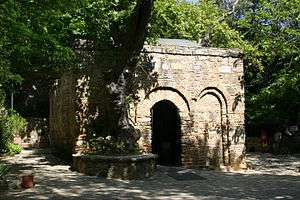
Key Marian devotions include: Seven Sorrows of Mary, Rosary and scapular, Miraculous Medal and Reparations to Mary.[94][95] The months of May and October are traditionally "Marian months" for Roman Catholics, e.g., the daily Rosary is encouraged in October and in May Marian devotions take place in many regions.[96][97][98] Popes have issued a number of Marian encyclicals and Apostolic Letters to encourage devotions to and the veneration of the Virgin Mary.
Catholics place high emphasis on Mary's roles as protector and intercessor and the Catechism refers to Mary as "honored with the title 'Mother of God,' to whose protection the faithful fly in all their dangers and needs".[89][99][100][101][102] Key Marian prayers include: Ave Maria, Alma Redemptoris Mater, Sub tuum praesidum, Ave maris stella, Regina caeli, Ave Regina caelorum and the Magnificat.[103]
Mary's participation in the processes of salvation and redemption has also been emphasized in the Catholic tradition, but they are not doctrines.[104][105][106][107] Pope John Paul II's 1987 encyclical Redemptoris Mater began with the sentence: "The Mother of the Redeemer has a precise place in the plan of salvation."[108]
In the 20th century both popes John Paul II and Benedict XVI have emphasized the Marian focus of the Church. Cardinal Joseph Ratzinger (later Pope Benedict XVI) suggested a redirection of the whole Church towards the program of Pope John Paul II in order to ensure an authentic approach to Christology via a return to the "whole truth about Mary,"[109] writing:
"It is necessary to go back to Mary if we want to return to that 'truth about Jesus Christ,' 'truth about the Church' and 'truth about man.'"[109]
Eastern Orthodox
Eastern Orthodox Christianity includes a large number of traditions regarding the Ever Virgin Mary, the Theotokos.[110] The Orthodox believe that she was and remained a virgin before and after Christ's birth.[25] The Theotokia (i.e., hymns to the Theotokos) are an essential part of the Divine Services in the Eastern Church and their positioning within the liturgical sequence effectively places the Theotokos in the most prominent place after Christ.[111] Within the Orthodox tradition, the order of the saints begins with: The Theotokos, Angels, Prophets, Apostles, Fathers, Martyrs, etc. giving the Virgin Mary precedence over the angels. She is also proclaimed as the "Lady of the Angels".[111]
The views of the Church Fathers still play an important role in the shaping of Orthodox Marian perspective. However, the Orthodox views on Mary are mostly doxological, rather than academic: they are expressed in hymns, praise, liturgical poetry and the veneration of icons. One of the most loved Orthodox Akathists (i.e. standing hymns) is devoted to Mary and it is often simply called the Akathist Hymn.[112] Five of the twelve Great Feasts in Orthodoxy are dedicated to Mary.[25] The Sunday of Orthodoxy directly links the Virgin Mary's identity as Mother of God with icon veneration.[113] A number of Orthodox feasts are connected with the miraculous icons of the Theotokos.[111]
The Orthodox view Mary as "superior to all created beings", although not divine.[114] As such, the designation of Saint to Mary as Saint Mary is not appropriate.[115] The Orthodox does not venerate Mary as conceived immaculate. Gregory of Nazianzus, Archbishop of Constantinople in the 4th century AD, speaking on the Nativity of Jesus Christ argues that "Conceived by the Virgin, who first in body and soul was purified by the Holy Ghost, He came forth as God with that which He had assumed, One Person in two Natures, Flesh and Spirit, of which the latter defined the former."[116] The Orthodox celebrate the Dormition of the Theotokos, rather than Assumption.[25]
The Protoevangelium of James, an extra-canonical book, has been the source of many Orthodox beliefs on Mary. The account of Mary's life presented includes her consecration as a virgin at the temple at age three. The high priest Zachariah blessed Mary and informed her that God had magnified her name among many generations. Zachariah placed Mary on the third step of the altar, whereby God gave her grace. While in the temple, Mary was miraculously fed by an angel, until she was twelve years old. At that point an angel told Zachariah to betroth Mary to a widower in Israel, who would be indicated. This story provides the theme of many hymns for the Feast of Presentation of Mary, and icons of the feast depict the story.[117] The Orthodox believe that Mary was instrumental in the growth of Christianity during the life of Jesus, and after his Crucifixion, and Orthodox theologian Sergei Bulgakov has written: "The Virgin Mary is the centre, invisible, but real, of the Apostolic Church."
Theologians from the Orthodox tradition have made prominent contributions to the development of Marian thought and devotion. John Damascene (c. 650–c. 750) was one of the greatest Orthodox theologians. Among other Marian writings, he proclaimed the essential nature of Mary's heavenly Assumption or Dormition and her meditative role.
It was necessary that the body of the one who preserved her virginity intact in giving birth should also be kept incorrupt after death. It was necessary that she, who carried the Creator in her womb when he was a baby, should dwell among the tabernacles of heaven.[118]
From her we have harvested the grape of life; from her we have cultivated the seed of immortality. For our sake she became Mediatrix of all blessings; in her God became man, and man became God.[119]
More recently, Sergei Bulgakov expressed the Orthodox sentiments towards Mary as follows:[114]
Mary is not merely the instrument, but the direct positive condition of the Incarnation, its human aspect. Christ could not have been incarnate by some mechanical process, violating human nature. It was necessary for that nature itself to say for itself, by the mouth of the most pure human being: "Behold the handmaid of the Lord, be it unto me according to Thy word."
Protestant
Protestants in general reject the veneration and invocation of the Saints.[12]:1174 Protestants typically hold the view that Mary was the mother of Jesus, but unlike Catholics, they believe that she was an ordinary woman who was also devoted to God. Therefore, there is virtually no Marian veneration, Marian feasts, Marian pilgrimages, Marian art, Marian music or Marian spirituality in today's Protestant communities. Within these views, Roman Catholic beliefs and practices are at times rejected, e.g., theologian Karl Barth wrote that "the heresy of the Catholic Church is its Mariology".[120]
Some early Protestants venerated and honored Mary. Martin Luther wrote that: "Mary is full of grace, proclaimed to be entirely without sin. God's grace fills her with everything good and makes her devoid of all evil."[121] However, as of 1532 Luther stopped celebrating the feast of the Assumption of Mary and also discontinued his support of the Immaculate Conception.[122] John Calvin remarked, "It cannot be denied that God in choosing and destining Mary to be the Mother of his Son, granted her the highest honor."[123] However, Calvin firmly rejected the notion that anyone but Christ can intercede for man.[124]
Although Calvin and Huldrych Zwingli honored Mary as the Mother of God in the 16th century, they did so less than Martin Luther.[125] Thus the idea of respect and high honor for Mary was not rejected by the first Protestants; but, they came to criticize the Roman Catholics for venerating Mary. Following the Council of Trent in the 16th century, as Marian veneration became associated with Catholics, Protestant interest in Mary decreased. During the Age of the Enlightenment, any residual interest in Mary within Protestant churches almost disappeared, although Anglicans and Lutherans continued to honor her.[12]
Protestants acknowledge that Mary is "blessed among women"[Luke 1:42] but they do not agree that Mary is to be venerated. She is considered to be an outstanding example of a life dedicated to God.[126]
In the 20th century, Protestants reacted in opposition to the Catholic dogma of the Assumption of Mary. The conservative tone of the Second Vatican Council began to mend the ecumenical differences, and Protestants began to show interest in Marian themes. In 1997 and 1998 ecumenical dialogues between Catholics and Protestants took place, but, to date, the majority of Protestants pay scant attention to Marian issues and often view them as a challenge to the authority of Scripture.[12]
Anglican
The multiple churches that form the Anglican Communion and the Continuing Anglican movement have different views on Marian doctrines and venerative practices given that there is no single church with universal authority within the Communion and that the mother church (the Church of England) understands itself to be both "Catholic" and "Reformed".[127] Thus unlike the Protestant churches at large, the Anglican Communion (which includes the Episcopal Church in the United States) includes segments which still retain some veneration of Mary.[84]
Mary's special position within God's purpose of salvation as "God-bearer" (Theotokos) is recognised in a number of ways by some Anglican Christians.[128] All the member churches of the Anglican Communion affirm in the historic creeds that Jesus was born of the Virgin Mary, and celebrates the feast days of the Presentation of Christ in the Temple. This feast is called in older prayer books the Purification of the Blessed Virgin Mary on 2 February. The Annunciation of our Lord to the Blessed Virgin on 25 March was from before the time of Bede until the 18th century New Year's Day in England. The Annunciation is called the "Annunciation of our Lady" in the 1662 Book of Common Prayer. Anglicans also celebrate in the Visitation of the Blessed Virgin on 31 May, though in some provinces the traditional date of 2 July is kept. The feast of the St. Mary the Virgin is observed on the traditional day of the Assumption, 15 August. The Nativity of the Blessed Virgin is kept on 8 September.[84]
The Conception of the Blessed Virgin Mary is kept in the 1662 Book of Common Prayer, on 8 December. In certain Anglo-Catholic parishes this feast is called the Immaculate Conception. Again, the Assumption of Mary is believed in by most Anglo-Catholics, but is considered a pious opinion by moderate Anglicans. Protestant minded Anglicans reject the celebration of these feasts.[84]
Prayers and venerative practices vary a great deal. For instance, as of the 19th century, following the Oxford Movement, Anglo-Catholics frequently pray the Rosary, the Angelus, Regina caeli, and other litanies and anthems of Our Lady that are reminiscent of Catholic practices.[129] On the other hand, Low-church Anglicans rarely invoke the Blessed Virgin except in certain hymns, such as the second stanza of Ye Watchers and Ye Holy Ones.[128][130]
The Anglican Society of Mary was formed in 1931 and maintains chapters in many countries. The purpose of the society is to foster devotion to Mary among Anglicans.[84][131] The high-church Anglicans espouse doctrines that are closer to Roman Catholics, and retain veneration for Mary, e.g., official Anglican pilgrimages to Our Lady of Lourdes have taken place since 1963, and pilgrimages to Our Lady of Walsingham have gone on for hundreds of years.[132]
Historically, there has been enough common ground between Roman Catholics and Anglicans on Marian issues that in 2005 a joint statement called Mary: grace and hope in Christ was produced through ecumenical meetings of Anglicans and Roman Catholic theologians. This document, informally known as the "Seattle Statement", is not formally endorsed by either the Catholic Church or the Anglican Communion, but is viewed by its authors as the beginning of a joint understanding of Mary.[84][133]
Lutheran
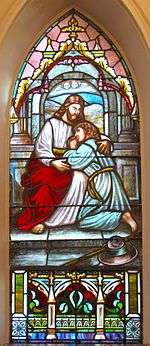
Despite Martin Luther's harsh polemics against his Roman Catholic opponents over issues concerning Mary and the saints, theologians appear to agree that Luther adhered to the Marian decrees of the ecumenical councils and dogmas of the church. He held fast to the belief that Mary was a perpetual virgin and Mother of God.[134][135] Special attention is given to the assertion that Luther, some three-hundred years before the dogmatization of the Immaculate Conception by Pope Pius IX in 1854, was a firm adherent of that view. Others maintain that Luther in later years changed his position on the Immaculate Conception, which, at that time was undefined in the Church, maintaining however the sinlessness of Mary throughout her life.[136][137] For Luther, early in his life, the Assumption of Mary was an understood fact, although he later stated that the Bible did not say anything about it and stopped celebrating its feast. Important to him was the belief that Mary and the saints do live on after death.[138][139][140] "Throughout his career as a priest-professor-reformer, Luther preached, taught, and argued about the veneration of Mary with a verbosity that ranged from childlike piety to sophisticated polemics. His views are intimately linked to his Christocentric theology and its consequences for liturgy and piety."[141] Luther, while revering Mary, came to criticize the "Papists" for blurring the line, between high admiration of the grace of God wherever it is seen in a human being, and religious service given to another creature. He considered the Roman Catholic practice of celebrating saints' days and making intercessory requests addressed especially to Mary and other departed saints to be idolatry.[142][143] His final thoughts on Marian devotion and veneration are preserved in a sermon preached at Wittenberg only a month before his death:
Therefore, when we preach faith, that we should worship nothing but God alone, the Father of our Lord Jesus Christ, as we say in the Creed: 'I believe in God the Father almighty and in Jesus Christ,' then we are remaining in the temple at Jerusalem. Again,'This is my beloved Son; listen to him.' 'You will find him in a manger'. He alone does it. But reason says the opposite:
What, us? Are we to worship only Christ? Indeed, shouldn't we also honor the holy mother of Christ? She is the woman who bruised the head of the serpent. Hear us, Mary, for thy Son so honors thee that he can refuse thee nothing. Here Bernard went too far in his Homilies on the Gospel: Missus est Angelus.[144] God has commanded that we should honor the parents; therefore I will call upon Mary. She will intercede for me with the Son, and the Son with the Father, who will listen to the Son. So you have the picture of God as angry and Christ as judge; Mary shows to Christ her breast and Christ shows his wounds to the wrathful Father. That's the kind of thing this comely bride, the wisdom of reason cooks up: Mary is the mother of Christ, surely Christ will listen to her; Christ is a stern judge, therefore I will call upon St. George and St. Christopher. No, we have been by God's command baptized in the name of the Father, the Son, and the Holy Spirit, just as the Jews were circumcised.[145][146]
Certain Lutheran churches such as the Anglo-Lutheran Catholic Church however, continue to venerate Mary and the saints in the same manner that Roman Catholics do, and hold all Marian dogmas as part of their faith.[147]
Methodist
Methodists do not have any additional teachings on the Virgin Mary except from what is mentioned in Scripture and the ecumenical Creeds. As such, Methodists generally accept the doctrine of the virgin birth, but reject the doctrine of the Immaculate Conception.[148] John Wesley, the principal founder of the Methodist movement within the Church of England, believed that Mary "continued a pure and unspotted virgin", thus upholding the doctrine of the perpetual virginity of Mary.[149][150] Contemporary Methodism does hold that Mary was a virgin before, during, and immediately after the birth of Christ.[151][152] In addition, some Methodists also hold the doctrine of the Assumption of Mary as a pious opinion.[153]
Nontrinitarian
Nontrinitarians, such as Unitarians, Christadelphians, Jehovah's Witnesses, and Latter Day Saints[154] also acknowledge Mary as the biological mother of Jesus Christ, but most reject any immaculate conception and do not recognize Marian titles such as "Mother of God". The Latter Day Saint movement's view affirms the virgin birth of Jesus[155] and Christ's divinity but only as a separate being than God the Father. The Book of Mormon refers to Mary by name in prophecies and describes her as "most beautiful and fair above all other virgins"[156] and as a "precious and chosen vessel."[157]
Since most non-trinitarian groups are typically also Christian mortalists, Mary is not seen as an intercessor between humankind and Jesus, whom mortalists would consider "asleep", awaiting resurrection.[158][159]
Jewish
The issue of the parentage of Jesus in the Talmud affects also the view of his mother. However, the Talmud does not mention Mary by name and is considerate rather than only polemic.[160][161] The story about Panthera is also found in the Toledot Yeshu, the literary origins of which can not be traced with any certainty, and given that it is unlikely to go before the 4th century, the time is now far too late to include authentic remembrances of Jesus.[162] The Blackwell Companion to Jesus states that the Toledot Yeshu has no historical facts and was perhaps created as a tool for warding off conversions to Christianity.[163] The tales from the Toledot Yeshu did impart a negative picture of Mary to ordinary Jewish readers.[164] The circulation of the Toledot Yeshu was widespread among European and Middle Eastern Jewish communities since the 9th century.[165] The name Panthera may be a distortion of the term parthenos (virgin) and Raymond E. Brown considers the story of Panthera a fanciful explanation of the birth of Jesus that includes very little historical evidence.[166] Robert Van Voorst states that because Toledot Yeshu is a medieval document with its lack of a fixed form and orientation towards a popular audience, it is "most unlikely" to have reliable historical information.[167] Stacks of the copies of the Talmud were burnt upon a court order after the 1240 Disputation for allegedly containing material defaming the character of Mary.[164]
Islamic
.jpg)
The Virgin Mary holds a singularly exalted place in Islam and she is considered by the Quran to have been the greatest woman in the history of humankind. The Islamic scripture recounts the Divine Promise given to Mary as being: "Mary! God has chosen thee, and purified thee; He hath chosen thee above all the women of creation" (3:42).
Mary is often referred to by Muslims by the honorific title "sayedetina" (our lady). She is mentioned in the Quran as the daughter of Imran.[168]
Moreover, Mary is the only woman named in the Quran and she is mentioned or referred to in the scripture a total of fifty times.[169] Mary holds a singularly distinguished and honored position among women in the Quran. A Sura (chapter) in the Quran is titled "Maryam" (Mary), which is the only Sura in the Quran named after a woman, in which the story of Mary (Maryam) and Jesus (Isa) is recounted according to the view of Jesus in Islam.[17]
Birth of Mary
In a narration of Hadith from Imam Ja'far al-Sadiq, he mentions that Allah revealed to Imran, "I will grant you a boy, blessed, one who will cure the blind and the leper and one who will raise the dead by My permission. And I will send him as an apostle to the Children of Israel." Then Imran related the story to his wife, Hannah, the mother of Mary. When she became pregnant, she conceived it was a boy, but when she gave birth to a girl, she stated "Oh my Lord! Verily I have delivered a female, and the male is not like the female, for a girl will not be a prophet," to which Allah replies in the Quran Allah knows better what has been delivered [3:36]. When Allah bestowed Jesus to Mary, he fulfilled his promise to Imran.[170]
Motherhood
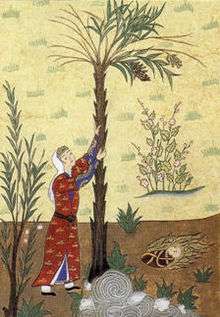
Mary was declared (uniquely along with Jesus) to be a "Sign of God" to humanity;[171] as one who "guarded her chastity";[42] an "obedient one";[42] "chosen of her mother" and dedicated to Allah whilst still in the womb;[172] uniquely (amongst women) "Accepted into service by God";[173] cared for by (one of the prophets as per Islam) Zakariya (Zacharias);[173] that in her childhood she resided in the Temple and uniquely had access to Al-Mihrab (understood to be the Holy of Holies), and was provided with heavenly "provisions" by God.[173][168]
Mary is also called a "Chosen One";[43] a "Purified One";[43] a "Truthful one";[174] her child conceived through "a Word from God";[175] and "exalted above all women of The Worlds/Universes (the material and heavenly worlds)".[43]
The Quran relates detailed narrative accounts of Maryam (Mary) in two places, Quran 3:35–47 and 19:16–34. These state beliefs in both the Immaculate Conception of Mary and the virgin birth of Jesus.[176][177][178] The account given in Sura 19 is nearly identical with that in the Gospel according to Luke, and both of these (Luke, Sura 19) begin with an account of the visitation of an angel upon Zakariya (Zecharias) and "Good News of the birth of Yahya (John)", followed by the account of the annunciation. It mentions how Mary was informed by an angel that she would become the mother of Jesus through the actions of God alone.[179]
In the Islamic tradition, Mary and Jesus were the only children who could not be touched by Satan at the moment of their birth, for God imposed a veil between them and Satan.[180] According to author Shabbir Akhtar, the Islamic perspective on Mary's Immaculate Conception is compatible with the Catholic doctrine of the same topic. "O People of the Book! Do not go beyond the bounds in your religion, and do not say anything of Allah but the truth. The Messiah, Jesus son of Mary, was but a Messenger of God, and a Word of His (Power) which He conveyed to Mary, and a spirit from Him. So believe in Allah (as the One, Unique God), and His Messengers (including Jesus, as Messenger); and do not say: (Allah is one of) a trinity. Give up (this assertion) – (it is) for your own good (to do so). Allah is but One Allah; All-Glorified He is in that He is absolutely above having a son. To Him belongs whatever is in the heavens and whatever is on the earth. And Allah suffices as the One to be relied on, to Whom affairs should be referred." Quran 4/171[181][182]
The Quran says that Jesus was the result of a virgin birth. The most detailed account of the annunciation and birth of Jesus is provided in Suras 3 and 19 of the Quran, where it is written that God sent an angel to announce that she could shortly expect to bear a son, despite being a virgin.[183]
Baha'i
The Bahá'í Faith venerates Mary as the mother of Jesus. The Kitáb-i-Íqán, the primary theological work of the Baha'i religion, describes Mary as "that most beauteous countenance," and "that veiled and immortal Countenance." It claims that Jesus was "conceived of the Holy Ghost."[184]
Others
Biblical scholars
The statement found in Matthew 1:25 that Joseph did not have sexual relations with Mary before she gave birth to Jesus has been debated among scholars, with some saying that she did not remain a virgin and some saying that she was a perpetual virgin.[185] Other scholars contend that the Greek word heos (i.e., until) denotes a state up to a point, but does not mean that the state ended after that point, and that Matthew 1:25 does not confirm or deny the virginity of Mary after the birth of Jesus.[186][187][188] According to Biblical scholar Bart Ehrman the Hebrew word almah, meaning young woman of childbearing age, was translated into Greek as parthenos, which often, though not always, refers to a young woman who has never had sex. In Isaiah 7:14 it is commonly believed by Christians to be the prophecy of the Virgin Mary referred to in Matthew 1:23.[189] While Matthew and Luke give differing versions of the virgin birth, John quotes the uninitiated Philip and the disbelieving Jews gathered at Galilee referring to Joseph as Jesus's father.[190][191][192][193]
Other biblical verses have also been debated, e.g., that the reference by Paul that Jesus was made "of the seed of David according to the flesh" (Romans 1:3) may be interpreted as Joseph being the father of Jesus.[194]
Pre-Christian Rome
From the early stages of Christianity, belief in the virginity of Mary and the virgin conception of Jesus, as stated in the gospels, holy and supernatural, was used by detractors, both political and religious, as a topic for discussions, debates and writings, specifically aimed to challenge the divinity of Jesus and thus Christians and Christianity alike.[195] In the 2nd century, as part of his anti-Christian polemic The True Word, the pagan philosopher Celsus contended that Jesus was actually the illegitimate son of a Roman soldier named Panthera.[196] The church father Origen dismissed this assertion as a complete fabrication in his apologetic treatise Against Celsus.[197] How far Celsus sourced his view from Jewish sources remains a subject of discussion.[198]
Christian devotion
3rd to 5th centuries
Christian devotion to Mary predates the emergence of a specific Marian liturgical system in the 5th century, following the First Council of Ephesus in 431. In Egypt the veneration of Mary had started in the 3rd century and the term Theotokos was used by Origen, the Alexandrian Father of the Church.[199] The earliest known Marian prayer (the Sub tuum praesidium, or Beneath Thy Protection) is from the 3rd century (perhaps 270), and its text was rediscovered in 1917 on a papyrus in Egypt.[200][201] Following the Edict of Milan in 313, by the 5th century artistic images of Mary began to appear in public and larger churches were being dedicated to Mary, e.g., S. Maria Maggiore in Rome.[202][203][204]
The Council of Ephesus itself was held at a church in Ephesus which had been dedicated to Mary about a hundred years before.[205][206][207] The Church of the Seat of Mary in Palestine was built shortly after the introduction of Marian liturgy at the council of Ephesus, in 456, by a widow named Ikelia.[208]
4th-century Arabia
According to the 4th-century heresiologist Epiphanius of Salamis the Virgin Mary was worshipped as a mother goddess in the Christian sect of Collyridianism, which was found throughout Arabia sometime during the 300s AD. Collyridianism had women performing priestly acts. They made bread offerings to the Virgin Mary. The group was condemned as heretical by the Roman Catholic Church and was preached against by Epiphanius of Salamis, who wrote about the group in his writings titled Panarion.[209]
The adoption of the mother of Jesus as a virtual goddess may represent a reintroduction of aspects of the worship of Isis. According to Sabrina Higgins, "When looking at images of the Egyptian goddess Isis and those of the Virgin Mary, one may initially observe iconographic similarities. These parallels have led many scholars to suggest that there is a distinct iconographic relationship between Isis and Mary. In fact, some scholars have gone even further, and have suggested, on the basis of this relationship, a direct link between the cult of Mary and that of Isis."[210] Conversely, Carl Olson and Sandra Miesel dispute the idea that Christianity copied elements of Isis's iconography, saying that the symbol of a mother and her child is part of the universal human experience.[211]
Byzantium
Ephesus is a cultic centre of Mary, the site of the first Church dedicated to her and the rumoured place of her death. Ephesus was previously a centre for worship of Artemis a virgin goddess; the Temple of Artemis there is regarded as one of the Seven Wonders of the Ancient World. The cult of Mary was furthered by Queen Theodora in the 6th century.[212][213] According to William E. Phipps, in the book Survivals of Roman Religion[214] "Gordon Laing argues convincingly that the worship of Artemis as both virgin and mother at the grand Ephesian temple contributed to the veneration of Mary."[215]
Middle Ages
The Middle Ages saw many legends about Mary, her parents, and even her grandparents.[216] The Virgin's popularity increased dramatically from the 12th century.[217] This rise in popularity was linked to the Vatican's designation of Mary as the mediatrix.[218][219]
Depiction in Renaissance art
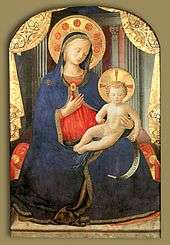
In paintings, Mary is traditionally portrayed in blue. This tradition can trace its origin to the Byzantine Empire, from c.500 AD, where blue was "the colour of an empress". A more practical explanation for the use of this colour is that in Medieval and Renaissance Europe, the blue pigment was derived from the rock lapis lazuli, a stone imported from Afghanistan of greater value than gold. Beyond a painter's retainer, patrons were expected to purchase any gold or lapis lazuli to be used in the painting. Hence, it was an expression of devotion and glorification to swathe the Virgin in gowns of blue. Transformations in visual depictions of the Virgin from the 13th to 15th centuries mirror her "social" standing within the Church as well as in society.[220]
Since the Reformation
Over the centuries, devotion and veneration to Mary has varied greatly among Christian traditions. For instance, while Protestants show scant attention to Marian prayers or devotions, of all the saints whom the Orthodox venerate, the most honored is Mary, who is considered "more honorable than the Cherubim and more glorious than the Seraphim".[25]
Orthodox theologian Sergei Bulgakov wrote: "Love and veneration of the Blessed Virgin Mary is the soul of Orthodox piety. A faith in Christ which does not include his mother is another faith, another Christianity from that of the Orthodox church."[114]
Although the Catholics and the Orthodox may honor and venerate Mary, they do not view her as divine, nor do they worship her. Roman Catholics view Mary as subordinate to Christ, but uniquely so, in that she is seen as above all other creatures.[221] Similarly Theologian Sergei Bulgakov wrote that the Orthodox view Mary as "superior to all created beings" and "ceaselessly pray for her intercession". However, she is not considered a "substitute for the One Mediator" who is Christ.[114] "Let Mary be in honor, but let worship be given to the Lord", he wrote.[222] Similarly, Catholics do not worship Mary as a divine being, but rather "hyper-venerate" her. In Roman Catholic theology, the term hyperdulia is reserved for Marian veneration, latria for the worship of God, and dulia for the veneration of other saints and angels.[223] The definition of the three level hierarchy of latria, hyperdulia and dulia goes back to the Second Council of Nicaea in 787.[224]
Devotions to artistic depictions of Mary vary among Christian traditions. There is a long tradition of Catholic Marian art and no image permeates Catholic art as does the image of Madonna and Child.[225] The icon of the Virgin Theotokos with Christ is without doubt the most venerated icon in the Orthodox Church.[226] Both Roman Catholic and Orthodox Christians venerate images and icons of Mary, given that the Second Council of Nicaea in 787 permitted their veneration with the understanding that those who venerate the image are venerating the reality of the person it represents,[227] and the 842 Synod of Constantinople confirming the same.[228] According to Orthodox piety and traditional practice, however, believers ought to pray before and venerate only flat, two-dimensional icons, and not three-dimensional statues.[229]
The Anglican position towards Mary is in general more conciliatory than that of Protestants at large and in a book he wrote about praying with the icons of Mary, Rowan Williams, former Archbishop of Canterbury, said: "It is not only that we cannot understand Mary without seeing her as pointing to Christ; we cannot understand Christ without seeing his attention to Mary."[84][230]
On 4 September 1781, 11 families of pobladores arrived from the Gulf of California and established a city in the name of King Carlos III. The small town was named El Pueblo de Nuestra Señora de los Ángeles de la Porciúncula (after our Lady of the Angels), a city that today is known simply as Los Angeles. In an attempt to revive the custom of religious processions within the Archdiocese of Los Angeles, in September 2011 the Queen of Angels Foundation, and founder Mark Anchor Albert, inaugurated an annual Grand Marian Procession in the heart of Downtown Los Angeles' historic core. This yearly procession, held on the last Saturday of August and intended to coincide with the anniversary of the founding of the City of Los Angeles, begins at the Cathedral of Our Lady of the Angels and concludes at the parish of La Iglesia de Nuestra Señora Reina de los Angeles which is part of the Los Angeles Plaza Historic District, better known as "La Placita".
Marian feasts
The earliest feasts that relate to Mary grew out of the cycle of feasts that celebrated the Nativity of Jesus. Given that according to the Gospel of Luke (Luke 2:22-40), forty days after the birth of Jesus, along with the Presentation of Jesus at the Temple Mary was purified according to Jewish customs, the Feast of the Purification began to be celebrated by the 5th century, and became the "Feast of Simeon" in Byzantium.[231]
In the 7th and 8th centuries four more Marian feasts were established in Eastern Christianity. In the West, a feast dedicated to Mary, just before Christmas was celebrated in the Churches of Milan and Ravenna in Italy in the 7th century. The four Roman Marian feasts of Purification, Annunciation, Assumption and Nativity of Mary were gradually and sporadically introduced into England by the 11th century.[231]
Over time, the number and nature of feasts (and the associated Titles of Mary) and the venerative practices that accompany them have varied a great deal among diverse Christian traditions. Overall, there are significantly more titles, feasts and venerative Marian practices among Roman Catholics than any other Christians traditions.[26] Some such feasts relate to specific events, e.g., the Feast of Our Lady of Victory was based on the 1571 victory of the Papal States in the Battle of Lepanto.[232][233]
Differences in feasts may also originate from doctrinal issues—the Feast of the Assumption is such an example. Given that there is no agreement among all Christians on the circumstances of the death, Dormition or Assumption of Mary, the feast of assumption is celebrated among some denominations and not others.[23][234] While the Catholic Church celebrates the Feast of the Assumption on 15 August, some Eastern Catholics celebrate it as Dormition of the Theotokos, and may do so on 28 August, if they follow the Julian calendar. The Eastern Orthodox also celebrate it as the Dormition of the Theotokos, one of their 12 Great Feasts. Protestants do not celebrate this, or any other Marian feasts.[23]
Catholic Mariology
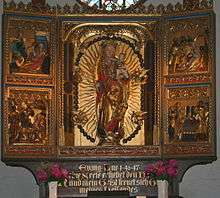
There is significant diversity in the Marian doctrines attributed to her primarily by the Catholic Church. The key Marian doctrines held primarily in Catholicism can be briefly outlined as follows:
- Immaculate Conception: Mary was conceived without original sin.
- Mother of God: Mary, as the mother of Jesus, is the Theotokos (God-bearer), or Mother of God.
- Virgin birth of Jesus: Mary conceived Jesus by action of the Holy Spirit while remaining a virgin.
- Perpetual Virginity: Mary remained a virgin all her life, even after the act of giving birth to Jesus.
- Dormition: commemorates Mary's "falling asleep" or natural death shortly before her Assumption.
- Assumption: Mary was taken bodily into Heaven either at, or before, her death.
The acceptance of these Marian doctrines by Roman Catholics can be summarized as follows:[12][235][236]
| Doctrine | Church action | Accepted by |
|---|---|---|
| Mother of God | First Council of Ephesus, 431 | Catholics, Eastern Orthodox, Oriental Orthodox, Anglicans, Lutherans, some Methodists |
| Virgin birth of Jesus | First Council of Nicaea, 325 | Catholics, Eastern Orthodox, Oriental Orthodox, Assyrians, Anglicans, Baptists, mainline Protestants |
| Assumption of Mary | Munificentissimus Deus encyclical Pope Pius XII, 1950 | Catholics, Eastern and Oriental Orthodox (only following her natural death), some Anglicans, some Lutherans |
| Immaculate Conception | Ineffabilis Deus encyclical Pope Pius IX, 1854 | Catholics, some Anglicans, some Lutherans (early Martin Luther) |
| Perpetual Virginity | Second Ecumenical Council of Constantinople, 553 Smalcald Articles, 1537 | Catholics, Eastern Orthodox, Oriental Orthodox, Assyrians, some Anglicans, some Lutherans (Martin Luther) |
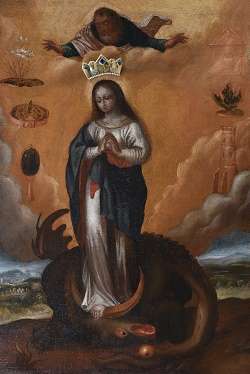
The title "Mother of God" (Theotokos) for Mary was confirmed by the First Council of Ephesus, held at the Church of Mary in 431. The Council decreed that Mary is the Mother of God because her son Jesus is one person who is both God and man, divine and human.[27] This doctrine is widely accepted by Christians in general, and the term Mother of God had already been used within the oldest known prayer to Mary, the Sub tuum praesidium which dates to around 250 AD.[237]
The Virgin birth of Jesus was an almost universally held belief among Christians from the 2nd until the 19th century.[238] It is included in the two most widely used Christian creeds, which state that Jesus "was incarnate of the Holy Spirit and the Virgin Mary" (the Nicene Creed in what is now its familiar form)[239] and the Apostles' Creed. The Gospel of Matthew describes Mary as a virgin who fulfilled the prophecy of Isaiah 7:14, mistranslating the Hebrew word alma ("young woman") in Isaiah 7:14 as "virgin", though. The authors of the Gospels of Matthew and Luke consider Jesus' conception not the result of intercourse and assert that Mary had "no relations with man" before Jesus' birth.[Mt 1:18] [Mt 1:25] [Lk 1:34] This alludes to the belief that Mary conceived Jesus through the action of God the Holy Spirit, and not through intercourse with Joseph or anyone else.[240]
The doctrines of the Assumption or Dormition of Mary relate to her death and bodily assumption to Heaven. The Roman Catholic Church has dogmatically defined the doctrine of the Assumption, which was done in 1950 by Pope Pius XII in Munificentissimus Deus. Whether the Virgin Mary died or not is not defined dogmatically, however, although a reference to the death of Mary are made in Munificentissimus Deus. In the Eastern Orthodox Church, the Assumption of the Virgin Mary is believed, and celebrated with her Dormition, where they believe she died.
Catholics believe in the Immaculate Conception of Mary, as proclaimed ex cathedra by Pope Pius IX in 1854, namely that she was filled with grace from the very moment of her conception in her mother's womb and preserved from the stain of original sin. The Latin Church has a liturgical feast by that name, kept on 8 December.[241] Orthodox Christians reject the Immaculate Conception dogma principally because their understanding of ancestral sin (the Greek term corresponding to the Latin "original sin") differs from the Augustinian interpretation and that of the Catholic Church.[242]
The Perpetual Virginity of Mary asserts Mary's real and perpetual virginity even in the act of giving birth to the Son of God made Man. The term Ever-Virgin (Greek ἀειπάρθενος) is applied in this case, stating that Mary remained a virgin for the remainder of her life, making Jesus her biological and only son, whose conception and birth are held to be miraculous.[86][240][243] While the Orthodox Churches hold the position articulated in the Protoevangelium of James that Jesus' brothers and sisters are older children of Joseph the Betrothed, step-siblings from an earlier marriage that left him widowed, Roman Catholic teaching follows the Latin father Jerome in considering them Jesus' cousins.
Cinematic portrayals
Mary has been portrayed in various films and on television, including:
- The Miracle (1912 color silent film of the play The Miracle (as a statue which comes to life))
- Das Mirakel (1912) silent film; a German version of the play The Miracle
- The Song of Bernadette (1943 film)
- The Living Christ Series (1951 non-theatrical, non-television film twelve-part series)
- The Miracle of Our Lady of Fatima (1952 film)
- Ben-Hur (1959 film), played by José Greci.[244]
- The Miracle (1959 film; a loose remake of the 1912 film Das Mirakel)
- King of Kings (1961 film), played by Siobhán McKenna.[245]
- The Greatest Story Ever Told (1965 film), played by Dorothy McGuire.[246]
- Jesus of Nazareth (1977 two-part television miniseries), played by Olivia Hussey.[247]
- The Last Temptation of Christ (1988 film), played by Verna Bloom.[248]
- Mary, Mother of Jesus (1999 television film), played by Pernilla August.[249]
- Saint Mary (2002 film), played by Shabnam Gholikhani.[250]
- The Passion of the Christ (2004 film), played by Maia Morgenstern.[251]
- Imperium: Saint Peter (2005 television film)
- Color of the Cross (2006 film), played by Debbi Morgan.[252]
- The Nativity Story (2006 film), played by Keisha Castle-Hughes.[253]
- The Passion (2008 television miniseries)[254][255]
- The Nativity (2010 four-part miniseries)
- Son of God (2014 film), played by Roma Downey.[256]
- Mary Magdalene (2018 film), played by Irit Sheleg.[257]
- Jesus: His Life (2019 TV series), played by Houda Echouafni.[258]
Image gallery
 Mary nursing the Infant Jesus. Early image from the Catacomb of Priscilla, Rome, c. 2nd century.
Mary nursing the Infant Jesus. Early image from the Catacomb of Priscilla, Rome, c. 2nd century.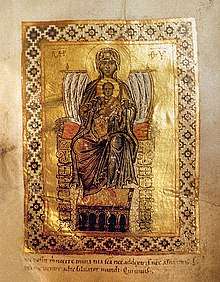 Theotokos Panachranta, from the 11th century Gertrude Psalter
Theotokos Panachranta, from the 11th century Gertrude Psalter Flight into Egypt by Giotto c. 1304
Flight into Egypt by Giotto c. 1304_basilica_inferiore_di_assisi_(1310-1329).jpg)
 Our Lady of Vladimir, a Byzantine representation of the Theotokos
Our Lady of Vladimir, a Byzantine representation of the Theotokos
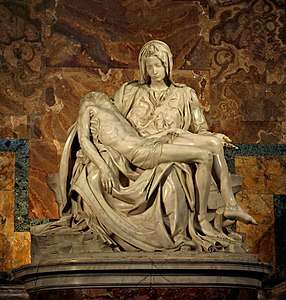
 Visitation, from the St Vaast Altarpiece by Jacques Daret, 1434–1435
Visitation, from the St Vaast Altarpiece by Jacques Daret, 1434–1435
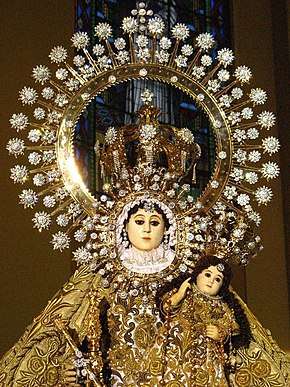
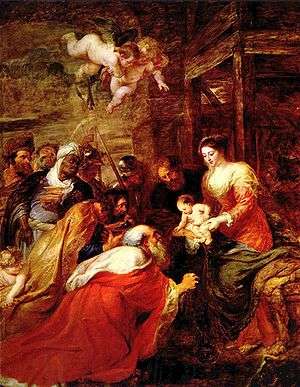 Adoration of the Magi, Rubens, 1634
Adoration of the Magi, Rubens, 1634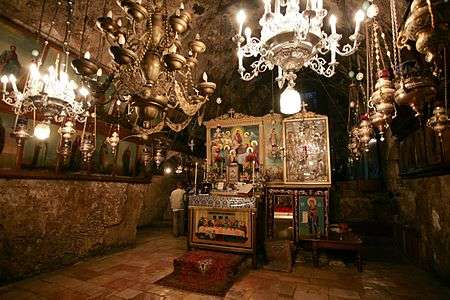 Inside of the Tomb of Mary, on the foothills of Mount of Olives, Jerusalem
Inside of the Tomb of Mary, on the foothills of Mount of Olives, Jerusalem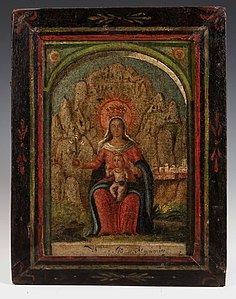 Virgin of Montserrat from Puetro Rico, ca. 1775-1825.
Virgin of Montserrat from Puetro Rico, ca. 1775-1825. Virgin and Child, French (15th century)
Virgin and Child, French (15th century)
Music
- Claudio Monteverdi: Vespro della Beata Vergine (1610)
- Johann Sebastian Bach: Magnificat (1723, rev. 1733)
- Franz Schubert: Ave Maria (1835)
- Charles Gounod: Ave Maria (1859)
See also
- Acts of Reparation to the Virgin Mary
- Anglican Roman Catholic International Commission
- Christian mythology
- Fleur de lys
- History of Catholic Mariology
- Holy Name of Mary
- Hortus conclusus
- La Conquistadora
- Litany of the Blessed Virgin Mary
- Marian apparition
- Madonna (art)
- Marian and Holy Trinity columns
- May crowning
- Miraculous births
- Mother of the Church
- New Testament people named Mary
- Shrines to the Virgin Mary
- Society of Mary (Marianists)
- Terra Mariana
Notes
- Undisputed according to the Bible and the Quran.
- The parents of Mary are unknown, but according to apocryphal gospels and some denominational traditions, it is Joachim and Anne. Some denomination traditions believe Heli and his wife to be the parents of Mary. Both are highly disputed. See Genealogy of Jesus § Explanations for divergence.
- Greek: Μαρία, romanized: María; Aramaic: ܡܪܝܡ, romanized: Mariam; Latin: Maria; Hebrew: מִרְיָם, romanized: Miriam; Coptic: Ⲙⲁⲣⲓⲁ, romanized: Maria; Arabic: مريم, romanized: Maryam; also known by various titles, styles and honorifics
References
- Pevehouse, James (2010). Spiritual Truths (1st ed.). Pittsburgh: Dorrance Publishing Company. p. 110. ISBN 9781434903044.
- Raymond Edward Brown; Joseph A. Fitzmyer; Karl Paul Donfried (1978). "consonant+with" Mary in the New Testament. NJ: Paulist Press. p. 140. ISBN 9780809121687.
consonant with Mary's Jewish background
- "Nazareth". britannica.com. Encyclopedia Britannica.
- (Greek: παρθένος, romanized: parthénos) Matthew 1:23 uses Greek parthénos virgin, whereas only the Hebrew of Isaiah 7:14, from which the New Testament ostensibly quotes, as Almah/young maiden. See article on parthénos in Bauercc/(Arndt)/Gingrich/Danker, A Greek-English Lexicon of the New Testament and Other Early Christian Literature, Second Edition, University of Chicago Press, 1979, p. 627.
- Browning, W. R. F. A dictionary of the Bible. 2004 ISBN 0-19-860890-X page 246
- Ruiz, Jean-Pierre. "Between the Crèche and the Cross: Another Look at the Mother of Jesus in the New Testament". New Theology Review; Aug. 2010, Vol. 23, Issue 3, pp. 3–4
- Munificentissimus Deus: Dogma of the Assumption by Pius XII, 1950, 17
- Holweck, Frederick (1907), The Feast of the Assumption,(The Catholic Encyclopedia), 2, New York: Robert Appleton Company, access date 18 April 2015
- Burke, Raymond L.; et al. (2008). Mariology: A Guide for Priests, Deacons, Seminarians, and Consecrated Persons ISBN 978-1-57918-355-4 page 178
- Mary for evangelicals by Tim S. Perry, William J. Abraham 2006 ISBN 0-8308-2569-X page 142
- "Mary, the mother of Jesus." The New Dictionary of Cultural Literacy, Houghton Mifflin. Boston: Houghton Mifflin, 2002. Credo Reference. Web. 28 September 2010.
- Encyclopedia of Protestantism, Volume 3 2003 by Hans Joachim Hillerbrand ISBN 0-415-92472-3 p. 1174
- Quran 3:42; cited in Stowasser, Barbara Freyer, "Mary", in: Encyclopaedia of the Qurʾān, General Editor: Jane Dammen McAuliffe, Georgetown University, Washington DC.
- J.D. McAuliffe, Chosen of all women
- J.-M. Abd-el-Jalil, Marie et l'Islam, Paris 1950
- Esposito, John. What Everyone Needs to Know About Islam. New York: University Press, 2002. P31.; cf. Stowasser, Barbara Freyer, "Mary", in: Encyclopaedia of the Qurʾān, General Editor: Jane Dammen McAuliffe, Georgetown University, Washington DC.
- Jestice, Phyllis G. Holy people of the world: a cross-cultural encyclopedia, Volume 3. 2004 ISBN 1-57607-355-6 page 558 Sayyidana Maryam
- "Mary", A Dictionary of First Names by Patrick Hanks, Kate Hardcastle and Flavia Hodges (27 July 2006). Oxford University Press. ISBN 0198610602.
- https://biblehub.com/matthew/1-25.htm
- "Jesus is described as the 'first-born son" of Mary in Mt 1:25 and Lk 2:7. From this wording alone we can conclude that there were later-born sons...The family [...] had at least five sons and an unknown number of daughters." Sabine R. Huebner, Papyri and the Social World of the New Testament (Cambridge University Press, 2019), 73. ISBN 1108470254
- Fulbert of Chatres, O Beata Virgo Maria, retrieved 27 March 2020
- Encyclopedia of Catholicism by Frank K. Flinn, J. Gordon Melton, 2007, ISBN 0-8160-5455-X, pages 443–444
- Hillerbrand, Hans Joachim. Encyclopedia of Protestantism, Volume 3, 2003. ISBN 0-415-92472-3, page 1174
- Jeremiah 44:17-19
- Eastern Orthodoxy through Western eyes by Donald Fairbairn 2002 ISBN 0-664-22497-0 page 99-101
- Flinn, Frank K., J. Gordon MeltonEncyclopedia of Catholicism. 2007 ISBN 0-8160-5455-X pages 443–444
- "The Canons of the Two Hundred Holy and Blessed Fathers Who Met at Ephesus". Ccel.org. 1 June 2005. Retrieved 30 September 2013.
- M'Corry, John StewartTheotokos: Or, the Divine Maternity. 2009 ISBN 1-113-18361-6 page 10
- The Christian theology reader by Alister E. McGrath 2006 ISBN 1-4051-5358-X page 273
- Luke 1:32
- Isaiah 9:6
- 1Ki 2:19-20
- 1 Kings 2:19-20
- Jeremiah 13:18-19
- What Every Catholic Should Know about Mary by Terrence J. McNally ISBN 1-4415-1051-6 page 128
- Legends of the Madonna by Anna Jameson 2009 1406853380 page 50
- Ann Ball, 2003 Encyclopedia of Catholic Devotions and Practices ISBN 0-87973-910-X page 515
- Candice Lee Goucher, 2007 World history: journeys from past to present ISBN 0-415-77137-4 page 102
- Ann Ball, 2003 Encyclopedia of Catholic Devotions and Practices ISBN 0-87973-910-X page 525
- Glassé, Cyril (2008). "Mary". The New Encyclopedia of Islam (3rd ed.). Plymouth, United Kingdom: Rowman & Littlefield Publishers, Inc. pp. 340–341. ISBN 9780742562967. Retrieved 2 June 2016.
- Quran 5:73–75
- Quran 66:12
- Quran 3:42
- William Temple, Readings in St John's Gospel. London: MacMillan, 1961. p. 35,36
- Ruiz, Jean-Pierre. "Between the Crèche and the Cross: Another Look at the Mother of Jesus in the New Testament." New Theology Review. Aug 2010, Vol. 23 Issue 3, pp. 5-15
- Smith, Scott. "Proving the Assumption of Mary". All Roads Lead to Rome. Retrieved 19 June 2017.
- "CHURCH FATHERS: The Perpetual Virginity of Mary (Jerome)". www.newadvent.org.
- "The Blessed Virgin Mary - Encyclopedia Volume - Catholic Encyclopedia - Catholic Online". Catholic Online.
- Douglas; Hillyer; Bruce (1990). New Bible Dictionary. Inter-varsity Press. p. 746. ISBN 978-0-85110-630-4.
- "New Advent Genealogy of Christ". Newadvent.org. 1 September 1909. Retrieved 30 September 2013.
- Henry, Matthew (1706). Luke in Matthew Henry commentary on the whole Bible (complete). Retrieved 18 April 2016.
- An event described by some Christians as the Annunciation Luke 1:35.
- Mills, Watson E., Roger Aubrey Bullard. Mercer dictionary of the Bible. 1998 ISBN 0-86554-373-9 page 429
- Luke 1:36
- Compare Luke 1:39-40 with Joshua 21:11 The Treasury of Scripture Knowledge says, "This was most probably Hebron, a city of the priests, and situated in the hill country of Judea, (Jos 11:21; 21:11, 13,) about 25 miles south of Jerusalem, and nearly 100 from Nazareth."
- The historicity of this census' relationship to the birth of Jesus continues to be one of scholarly disagreement; see e.g. p. 71 in Edwards, James R. (2015). The Gospel of Luke. Grand Rapids MI: Eerdmans. ISBN 9780802837356.
- Brown, Raymond Edward. Mary in the New Testament. 1978 ISBN 978-0-8091-2168-7
- The Gospel of Matthew by R. T. France 2007 ISBN 0-8028-2501-X p. 53
- Walvoord, John F., Roy B. Zuck. The Bible Knowledge Commentary: New Testament edition. 1983 ISBN 0-88207-812-7
- [Mt 1:24-25] [12:46] [13:54-56] [27:56] [Mk 3:31] [6:3] [15:40] [16:1] [Jn 2:12] [7:3-5] [Gal 1:19] [Ac 1:14]
- Eerdmans Dictionary of the Bible by D. N. Freedman, David Noel, Allen Myers and Astrid B. Beck (31 December 2000) ISBN 9053565035 page 202
- The Bible: The Basics by John Barton (2 March 2010) Routledge ISBN 0415411351 page 7
- Gaventa, Beverly Roberts. Mary: glimpses of the mother of Jesus. 1995 ISBN 1-57003-072-3, p.70
- de Bles, Arthur. How to Distinguish the Saints in Art by Their Costumes, Symbols and Attributes, 2004 ISBN 1-4179-0870-X page 35
- Jameson, Anna. Legends of the Madonna: as represented in the fine arts. 2006 ISBN 1-4286-3499-1 page 37
- Stephen J. Shoemaker, Ancient Traditions of the Virgin Mary's Dormition and Assumption Archived 11 March 2007 at the Wayback Machine (Oxford: Oxford University Press, 2002, 2006); De Obitu S. Dominae as noted in; Holweck, F. (1907). The Feast of the Assumption. In The Catholic Encyclopedia. New York: Robert Appleton Company.
- "''Munificentissimus Deus'' on the Assumption". Vatican.va. Retrieved 30 September 2013.
- Coptic Church website, Accessed 2010/10/6.
- Ronald Brownrigg, Canon Brownrigg Who's Who in the New Testament 2001 ISBN 0-415-26036-1 page T-62
- "Catholic Encyclopedia: St. Joseph". Newadvent.org. Retrieved 30 September 2013.
- Allison, Dale C., Matthew: A Shorter Commentary, p.12 Continuum International Publishing Group, 2004 ISBN 0-567-08249-0
- Rainer Riesner (1998). Paul's early period: chronology, mission strategy, theology. ISBN 9780802841667. Retrieved 20 August 2011.
- The Oxford handbook of early Christian studies by Susan Ashbrook Harvey, David G. Hunter 2008 ISBN 9780199271566 page 527
- The reception and interpretation of the Bible in late antiquity by Lorenzo DiTommaso, Lucian Turcescu 2008 ISBN 9004167153 page 507
- Maximus's Mary, by Sally Cuneen, Commonweal Magazine, 4 December 2009
- "Anna Katharina Emmerick (1774-1824), biography". Vatican.va. Retrieved 30 September 2013.
- Emmerich, Anna Catherine: The Dolorous Passion of Our Lord Jesus Christ ISBN 978-0-89555-210-5 page viii
- Frommer's Turkey by Lynn A. Levine 2010 ISBN 0470593660 pages 254-255
- Home of the Assumption: Reconstructing Mary's Life in Ephesus by V. Antony John Alaharasan 2006 ISBN 1929039387 page 38
- The Ancient Traditions of the Virgin Mary's Dormition and Assumption by Stephen J. Shoemaker 2006 ISBN 0199210748 page 76
- Mary's House by Donald Carroll (20 April 2000) Veritas, ISBN 0953818802
- Irenaeus, Adversus haereses III,1,1; Eusebius of Caesarea, Church History, III,1
- "CATHOLIC ENCYCLOPEDIA: Tomb of the Blessed Virgin Mary". Newadvent.org. 1 July 1912. Retrieved 30 September 2013.
- Schroedel, Jenny The Everything Mary Book, 2006 ISBN 1-59337-713-4 pages 81–85
- Miegge, Giovanni, The Virgin Mary: Roman Catholic Marian Doctrine, pgs. 15–22, Westminster Press, Philadelphia, 1963.
- Fahlbusch, Erwin, et al. The encyclopedia of Christianity, Volume 3 2003 ISBN 90-04-12654-6 pages 403–409
- Merriam-Webster's encyclopedia of world religions by Wendy Doniger, 1999 ISBN 0-87779-044-2 page 696
- "Encyclical Ad Caeli Reginam". Vatican.
- "CCC, 971". Vatican.va.
- The Catholicism Answer Book by John Trigilio, Kenneth Brighenti 2007 ISBN 1-4022-0806-5 page 325
- "Vatican website: Marian consecration and entrustment, item 204". Vatican.va. Retrieved 30 September 2013.
- Schroede, Jenny, The Everything Mary Book 2006 ISBN 1-59337-713-4 page 219
- O'Carroll, Michael, The Alliance of the Hearts of Jesus and Mary 2007, ISBN 1-882972-98-8 pages 10–15
- "Catholic Encyclopedia: Devotion to the Blessed Virgin Mary". NewAdvent.org. 1 October 1912. Retrieved 30 September 2013.
- "Cardinal Urges Devotion to Rosary and Scapular". Zenit.org. 17 July 2008. Archived from the original on 14 November 2012. Retrieved 30 September 2013.
- Handbook of Prayers by James Socías 2006 ISBN 0-87973-579-1 page 483
- The encyclopedia of Christianity, Volume 4 by Erwin Fahlbusch, Geoffrey William Bromiley 2005 ISBN 0-8028-2416-1 page 575
- Pope Leo XIII. "Encyclical of Pope Leo XIII on the Rosary". Octobri Mense. Vatican. Retrieved 4 October 2010.
- A Beginner's Book of Prayer: An Introduction to Traditional Catholic Prayers by William G. Storey 2009 ISBN 0-8294-2792-9 page 99
- Ann Ball, 2003 Encyclopedia of Catholic Devotions and Practices ISBN 0-87973-910-X page 365
- Our Sunday Visitor's Catholic Almanac by Matthew Bunson 2009 ISBN 1-59276-441-X page 122
- The Catholic Handbook for Visiting the Sick and Homebound by Corinna Laughlin, Sara McGinnis Lee 2010 ISBN 978-1-56854-886-9 page 4
- Geoghegan. G.P. A Collection of My Favorite Prayers, 2006 ISBN 1-4116-9457-0 pages 31, 45, 70, 86, 127
- Mary, mother of the redemption by Edward Schillebeeckx 1964 ASIN B003KW30VG pages 82–84
- Mary in the Redemption by Adrienne von Speyr 2003 ISBN 0-89870-955-5 pages 2–7
- Salvation Through Mary by Henry Aloysius Barry 2008 ISBN 1-4097-3172-3 pages 13–15
- The mystery of Mary by Paul Haffner 2004 ISBN 0-85244-650-0 page 198
- "''Redemptoris Mater'' at the Vatican website". Vatican.va. Retrieved 30 September 2013.
- Burke, Raymond L.; et al. (2008). Mariology: A Guide for Priests, Deacons, Seminarians, and Consecrated Persons ISBN 978-1-57918-355-4 page xxi
- McNally, Terrence, What Every Catholic Should Know about Mary ISBN 1-4415-1051-6 pages 168–169
- Ecclesiasticus II: Orthodox Icons, Saints, Feasts and Prayer by George Dion Dragas 2005 ISBN 0-9745618-0-0 pages 81–83
- The Everything Mary Book by Jenny Schroedel 2006 ISBN 1-59337-713-4 page 90
- Vasilaka, Maria Images of the Mother of God: perceptions of the Theotokos in Byzantium 2005 ISBN 0-7546-3603-8 page 97
- The Orthodox Church by Serge? Nikolaevich Bulgakov 1997 ISBN 0-88141-051-9 page 116
- "Orthodox Holiness :: The Titles Of The Saints". www.orthodoxengland.org.uk. Retrieved 30 July 2019.
- Gregorius Nazianzenus. In theophania. Documenta Catholica Omnia.
- Wybrew, Hugh Orthodox feasts of Jesus Christ & the Virgin Mary: liturgical texts 2000 ISBN 0-88141-203-1 pages 37–46
- Damascene, John. Homily 2 on the Dormition 14; PG 96, 741 B
- Damascene, John. Homily 2 on the Dormition 16; PG 96, 744 D
- Barth, Karl, Church dogmatics, 1, pp. 143–4, ISBN 978-0-567-05069-4
- Lehmann, H., ed. Luther's Works, American edition, vol. 43, p. 40, Fortress, 1968.
- Lee (1993), Catholic, Lutheran, Protestant: a doctrinal comparison, p. 249, ISBN 978-0-615-16635-3
- Alternately: "It cannot even be denied that God conferred the highest honour on Mary, by choosing and appointing her to be the mother of his Son."
Commentary on a Harmony of the Evangelists, Matthew, Mark, and Luke, 1845, Jean Calvin, Rev. William Pringle, Edinburgh, Volume 2, page 87 quote.
- "Neque etiam negari potest, quin Deus Mariam Filio suo matrem eligens ac destinans summo eam honore dignatus sit." Calvin's Opera, vol. 45 (Corpus Reformatorum, vol. 73), p. 348. no preview
- McKim, Donald K (2004), The Cambridge companion to John Calvin, ISBN 978-0-521-01672-8
- Haffner, Paul (2004), The mystery of Mary, p. 11, ISBN 978-0-85244-650-8
- Geisler, Norman L; MacKenzie, Ralph E (1995), Roman Catholics and Evangelicals: agreements and differences, p. 143, ISBN 978-0-8010-3875-4
- Milton, Anthony Catholic and Reformed 2002 ISBN 0-521-89329-1 page 5
- Braaten, Carl, et al. Mary, Mother of God 2004 ISBN 0-8028-2266-5 page 13
- Burnham, Andrew A Pocket Manual of Anglo-Catholic Devotion 2004 ISBN 1-85311-530-4 pages 1, 266,310, 330
- Duckworth, Penelope, Mary: The Imagination of Her Heart 2004 ISBN 1-56101-260-2 page 3-5
- Church of England yearbook: Volume 123 2006 ISBN 0-7151-1020-9 page 315
- Perrier, Jacques, Lourdes Today and Tomorrow 2008 1565483057 ISBN page 56
- Mary: grace and hope in Christ: the Seattle statement of the Anglican-Roman Catholics by the Anglican/Roman Catholic International Group 2006 ISBN 0-8264-8155-8 pages 7–10
- Bäumer, Remigius. Marienlexikon Gesamtausgabe, Leo Scheffczyk, ed., (Regensburg: Institutum Marianum, 1994), 190.
- Schroedel, Jenny (2006), The Everything Mary Book, pp. 125–6, ISBN 978-1-59337-713-7
- Jackson, Gregory Lee (1993), Catholic, Lutheran, Protestant: a doctrinal comparison, p. 249, ISBN 978-0-615-16635-3
- Bäumer, 191
- Haffner, Paul (2004), The mystery of Mary, p. 223, ISBN 978-0-85244-650-8
- Bäumer, 190.
- Colonna, Vittoria; Matraini, Chiara; Marinella, Lucrezia (2009). Who Is Mary?. p. 34. ISBN 978-0-226-11400-2.
- Eric W. Gritsch (1992). H. George Anderson; J. Francis Stafford; Joseph A. Burgess (eds.). The One Mediator, The Saints and Mary, Lutherans and Roman Catholic in Dialogue. VII. Minneapolis: Augsburg Fortress. p. 235.
- Luther's Works, 47, pp. 45f.
- Lutherans and Catholics in Dialogue VIII, p. 29.
- Clairvaux, Saint Bernard de (1476). Homiliae S. Bernardi super evangelio : "Missus est angelus Gabriel" - saint Bernard de Clairvaux - Google Boeken. Retrieved 30 September 2013.
- Doberstein, John W; Lehmann, Helmut T, eds. (1959) [1546], "Sermon on the Second Sunday after Epiphany", Luther's Works, 51 Sermons I, Fortress Press, p. 375, ISBN 978-0-8006-0351-9
- Dr. Martin Luthers Werke, Kritische Gesamtausgabe, 51, Weimar, 1883, p. 128
- More FAQ | The Anglo-Lutheran Catholic Church archiveaccessdate=11 September 2014
- "What does The United Methodist Church teach about the Immaculate Conception and the Virgin Birth?". Archives.umc.org. 6 November 2006. Retrieved 30 September 2013.
- Wesley's Letters, The Wesley Center Online, 1749, archived from the original on 5 November 2011
- "Mary's Perpetual Virginity". Davidmacd.com. Archived from the original on 25 August 2012. Retrieved 30 September 2013.
- "What does The United Methodist Church teach about the Virgin Mary?". Archives.umc.org. 6 November 2006. Retrieved 30 September 2013.
- "Comparing Christian Denominations – Beliefs: Nature of Mary". Christianity.about.com. 30 July 2013. Retrieved 30 September 2013.
- Stepp, Todd (23 December 2009). "Theotokos; Mary, Mother of God". Wesleyan/Anglican Society.
We Protestants (for the most part) tend to say something to the affect [sic] that, if it is not found in Scripture it is not held to be required as an article of faith. Thus, the assumption of Mary would not be held as an article of faith (i.e., as a required doctrine). However, in as much as the Scripture does not say that Mary was not assumed into heaven, and, in as much as we do have other instances of some sort of "assumption" in Scripture (e.g., Elijah, as mentioned, before), there seems to be nothing that would require that a Protestant Christian could not have a private "opinion" (in the Wesleyan sense of the term) that agrees with Rome or Constantinople (at least regarding Mary's assumption).
Missing or empty|url=(help) - Introduction to New and Alternative Religions in America 2006 Page 73 Eugene V. Gallagher, W. Michael Ashcraft "Jehovah's Witnesses pray to God in the name of Jesus, but insist that the Bible never identifies Christ as an eternal ... Jehovah God caused an ovum, or egg cell, in Mary's womb to become fertile, accomplishing this by the transferral of "
- Colton, Eleanor (1992), "Virgin Birth", Encyclopedia of Mormonism, 4, New York, NY: Macmillan Publishing Co., p. 1510
- 1 Nephi 11:13–20
- Alma 7:10
- Christian mortalism from Tyndale to Milton Norman T. Burns - 1972
- Fronk, Camille (1992), "Mary, Mother of Jesus", Encyclopedia of Mormonism, 2, New York, NY: Macmillan Publishing Co., pp. 863–64
- The Talmud Yerushalmi and Graeco-Roman culture: Volume 3 - Page 369 Peter Schäfer, Catherine Hezser - 2002 The Mother of the Messiah in the Talmud Yerushalmi and Sefer Zerubbabel by Martha Himmelfarb "Through the centuries the Virgin Mary has played a central role in Christian piety. Unlike so many aspects of Christianity, veneration of the ..."
- Peter Schäfer Mirror of His beauty: feminine images of God from the Bible to the ..2002 Page 233 "On the one hand, it mockingly disapproves of the idea of the mother of God; on the other hand, it treats Mary considerately and by no means only polemically. The talmudic and post-talmudic discussions about the Virgin Mary are classic ..."
- Van Voorst, Robert E (2000). Jesus Outside the New Testament: An Introduction to the Ancient Evidence WmB Eerdmans Publishing. ISBN 0-8028-4368-9 pp. 122 and 127
- Michael J. Cook Jewish Perspectives on Jesus Chapter 14 in "The Blackwell Companion to Jesus" edited by Delbert Burkett 2011 ISBN 978-1-4443-2794-6
- Amy G. Remensnyder (March 2014). La Conquistadora: The Virgin Mary at War and Peace in the Old and New Worlds. OUP USA. pp. 138–. ISBN 978-0-19-989300-3.
- Robert Van Voorst (13 April 2000). Jesus Outside the New Testament: An Introduction to the Ancient Evidence. Wm. B. Eerdmans Publishing. pp. 122–. ISBN 978-0-8028-4368-5.
- Mary in the New Testament by Raymond Edward Brown, et al. 1978 ISBN 0-8091-2168-9 page 262
- Van Voorst, Robert E (2000). Jesus Outside the New Testament: An Introduction to the Ancient Evidence WmB Eerdmans Publishing. ISBN 0-8028-4368-9 page 128
- The new encyclopedia of Islam by Cyril Glassé, Huston Smith 2003 ISBN 0-7591-0190-6 page 296 sayyidatuna
- See the following verses: 5:114, 5:116, 7:158, 9:31, 17:57, 17:104, 18:102, 19:16, 19:17, 19:18, 19:20, 19:22, 19:24, 19:27, 19:28, 19:29, 19:34, 21:26, 21:91, 21:101, 23:50, 25:17, 33:7, 39:45, 43:57, 43:61, 57:27, 61:6, 61:14, 66:12.
- Qa'im, Mahdi Muntazir (2007). Jesus Through the Qur'an and Shi'ite Narrations (bilingual ed.). Queens, New York: Tahrike Tarsile Qur'an. p. 16. ISBN 978-1879402140.
- Quran 23:50
- Quran 3:36
- Quran 3:37
- Quran 5:75
- Quran 3:45
- Jomier, Jacques. The Bible and the Qur'an. 2002 ISBN 0-89870-928-8 page 133
- Nazir-Ali, Michael. Islam, a Christian perspective. 1984 ISBN 0-664-24527-7 page 110
- "The Virgin Mary In The Koran". EWTN.com. 13 April 1978. Retrieved 30 September 2013.
- Jackson, Montell. Islam Revealed. 2003 ISBN 1-59160-869-4 page 73
- Rodwell, J. M. The Koran. 2009 ISBN 0-559-13127-5 page 505
- Akhtar, Shabbir.The Quran and the secular mind: a philosophy of Islam. 2007 page 352
- Glassé, Cyril, Huston Smith. The new encyclopedia of Islam. 2003 ISBN 0-7591-0190-6 page 240
- Sarker, Abraham.Understand My Muslim People. 2004 ISBN 1-59498-002-0 page 260 no preview
- The Kitáb-i-Íqán Part One. Baha'i Reference Library. Retrieved 10 September 2014.
- Coogan, Michael (October 2010). God and Sex. What the Bible Really Says (1st ed.). New York, Boston: Twelve. Hachette Book Group. p. 39. ISBN 978-0-446-54525-9. Retrieved 5 May 2011.
god and sex.
- McNally, Terrence, What Every Catholic Should Know about Mary ISBN 1-4415-1051-6 page 95
- Cradle of redeeming love by John Saward 2002 Ignatius Press ISBN 0-89870-886-9 page 17
- Mary in the New Testament by Raymond Edward Brown 1978 ISBN 0-8091-2168-9 page 86
- Ehrman, Bart Did Jesus Exist page 294
- John 1:45
- John 6:42
- Ehrman, Bart D. (2008). Whose Word is It?: The Story Behind who Changed the New Testament and why. A&C Black. pp. 158–. ISBN 978-1-84706-314-4.
- Ehrman, Bart D. (26 July 1999). Jesus: Apocalyptic Prophet of the New Millennium. Oxford University Press. pp. 96–. ISBN 978-0-19-983943-8.
- Coogan, Michael (October 2010). God and Sex. What the Bible Really Says (1st ed.). New York, Boston: Twelve. Hachette Book Group. p. 38. ISBN 978-0-446-54525-9. Retrieved 5 May 2011.
god and sex.
- Bennett, Clinton, In search of Jesus 2001 ISBN 0-8264-4916-6 pages 165–170
- Also see: Schaberg, Jane. Illegitimacy of Jesus: A Feminist Theological Interpretation of the Infancy Narratives (Biblical Seminar Series, No 28), ISBN 1-85075-533-7.
- Contra Celsum by Origen, Henry Chadwick (Cambridge: Cambridge University Press, 1953) reprint 1980 ISBN 0-521-29576-9 page 32
- John Patrick The Apology of Origen in Reply to Celsus 1892 reprint 2009 ISBN 1-110-13388-X pages 22–24
- Benz, Ernst The Eastern Orthodox Church: Its Thought and Life 2009 ISBN 0-202-36298-1 page 62
- Burke, Raymond et al. Mariology: A Guide for Priests, Deacons, Seminarians, and Consecrated Persons 2008 ISBN 978-1-57918-355-4 page 178
- The encyclopedia of Christianity, Volume 3 by Erwin Fahlbusch, Geoffrey William Bromiley 2003 ISBN 90-04-12654-6 page 406
- "CATHOLIC ENCYCLOPEDIA: Constantine the Great". Newadvent.org. Retrieved 30 September 2013.
- Osborne, John L. "Early Medieval Painting in San Clemente, Rome: The Madonna and Child in the Niche" Gesta 20.2 (1981:299–310) and (note 9) referencing T. Klauser, Rom under der Kult des Gottesmutter Maria, Jahrbuch für der Antike und Christentum 15 (1972:120–135).
- "The Papal Basilica of Santa Maria Maggiore". Vatican.va. Retrieved 30 September 2013.
- Baldovin, John and Johnson, Maxwell, Between memory and hope: readings on the liturgical year 2001 ISBN 0-8146-6025-8 page 386
- Dalmais, Irénée et al. The Church at Prayer: The liturgy and time 1985 ISBN 0-8146-1366-7 page 130
- McNally, Terrence, What Every Catholic Should Know about Mary ISBN 1-4415-1051-6 page 186
- Avner, Rina (2016). Leslie Brubaker; Mary B. Cunningham (eds.). The Initial Tradition of the Theotokos at the Kathisma: Earliest Celebrations and the Calendar. The Cult of the Mother of God in Byzantium: Texts and Images. Birmingham Byzantine and Ottoman Studies. Routledge. ISBN 9781351891974. Retrieved 8 January 2019.
- Collyridianism - EWTN Retrieved 11 September 2014
- Journal of the Canadian Society for Coptic Studies 3–4 — 2012 Sabrina Higgins: "Divine Mothers: The Influence of Isis on the Virgin Mary in Egyptian Lactans-Iconography"
- Carl Olson; Sandra Miesel (2004). The Da Vinci Hoax: Exposing the Errors in The Da Vinci Code. Ignatius Press. ISBN 978-1-58617-034-9.
- Ephesus.us. "Mysterious facts about Ephesus, Ephesus Turkey". www.ephesus.us.
- "Virgin Mary - Justinian - Theotokus - Theodora - Kate Cooper - Divine Women". 18 July 2015.
- Laing, Gordon. "Survivals of Roman Religion".
- Phipps, William E. (2008). Supernaturalism in Christianity: Its Growth and Cure. Mercer University Press. p. 46. ISBN 978-0881460940. Retrieved 10 November 2015.
- Toronto Star article - In December 2010, Catherine Lawless of the University of Limerick stated that by analyzing 15th-century Florentine manuscripts, she had concluded that Ismeria was the maternal grandmother of Mary. Toronto Star Dec 2010 Discovery News
- Mâle, Emile (1978). Religious Art in France: The Twelfth Century. Translated by Mathews, Marthiel.
- Warner, Marina (1976). Alone of All her Sex: The Myth and the Cult of the Virgin Mary.
- Pelikan, Jaroslav (1996). Mary Through the Centuries: Her Place in the History of Culture. Yale University Press.
- Kugeares, Sophia Manoulian (1991). Images Of The Annunciation Of The Virgin Mary Of The 13th, 14th And 15th Century.
- Miravalle, Mark. Introduction to Mary. 1993 Queenship Publishing ISBN 978-1-882972-06-7 pages 92–93
- The Orthodox word, Volumes 12–13, 1976 page 73
- Trigilio, John and Brighenti, Kenneth The Catholicism Answer Book 2007 ISBN 1-4022-0806-5 page 58
- The History of the Christian Church by Philip Smith 2009 ISBN 1-150-72245-2 page 288
- The Celebration of Faith: The Virgin Mary by Alexander Schmemann 2001 ISBN 0-88141-141-8 p. 11
- De Sherbinin, Julie Chekhov and Russian religious culture: the poetics of the Marian paradigm 1997 ISBN 0-8101-1404-6 p. 15
- "Pope John Paul II, General Audience, 1997". Vatican.va. 29 October 1997. Retrieved 30 September 2013.
- Kilmartin Edward The Eucharist in the West 1998 ISBN 0-8146-6204-8 page 80
- Ciaravino, Helene How to Pray 2001 ISBN 0-7570-0012-6 page 118
- Williams, Rowan Ponder these things: praying with icons of the Virgin 2002 ISBN 1-85311-362-X page 7
- Clayton, Mary. The Cult of the Virgin Mary in Anglo-Saxon England. 2003 ISBN 0-521-53115-2 pages 26–37
- EWTN on Battle of Lepanto (1571) Our Lady and Islam: Heaven's Peace Plan - EWTN
- by Butler, Alban, Peter Doyle. Butler's Lives of the Saints. 1999 ISBN 0-86012-253-0 page 222
- Jackson, Gregory Lee, Catholic, Lutheran, Protestant: a doctrinal comparison. 1993 ISBN 978-0-615-16635-3 page 254
- Jackson, Gregory Lee.Catholic, Lutheran, Protestant: a doctrinal comparison. 1993 ISBN 978-0-615-16635-3 page 254
- Miravalle, Mark. Introduction to Mary. 1993 Queenship Publishing ISBN 978-1-882972-06-7 page 51
- Miravalle, Mark Introduction to Mary, 1993, ISBN 978-1-882972-06-7, pages 44–46
- "Virgin Birth" britannica.com. Retrieved 22 October 2007.
- Translation by the ecumenical English Language Liturgical Consultation, given on page 17 of Praying Together, a literal translation of the original, "σαρκωθέντα ἐκ Πνεύματος Ἁγίου καὶ Μαρίας τῆς Παρθένου" archiveaccessdate 11 September 2014
- Miravalle, Mark Introduction to Mary, 1993, ISBN 978-1-882972-06-7, pages 56–64
- "Catholic Encyclopedia: Immaculate Conception". Newadvent.org. Retrieved 2 March 2010.
- Ware, Timothy. The Orthodox Church (Penguin Books, 1963, ISBN 0-14-020592-6), pp. 263–4.
- "CCC, 499". Vatican.va. .
- Hayes, R. M. (1986). Trick cinematography: the Oscar special-effects movies. McFarland Publishing. p. 149. ISBN 9780899501574.
- Ray, Nicholas (10 September 1993). Rey, Susan (ed.). I Was Interrupted: Nicholas Ray on Making Movies. University of California Press. p. 230. ISBN 9780520916678.
- Keller, Rosemary Skinner; Ruether, Rosemary Radford; Cantlon, Marie (2006). Encyclopedia of Women and Religion in North America: Native American creation stories. Indiana University Press. p. 1012. ISBN 9780253346872.
- Nicholson, Amy (1 August 2018). "Olivia Hussey, star of Zeffirelli's Romeo and Juliet: 'I was wild'". The Guardian. Guardian News & Media Limited. Retrieved 11 April 2019.
- Lindlof, Thomas (8 August 2008). Hollywood Under Siege: Martin Scorsese, the Religious Right, and the Culture Wars. University Press of Kentucky. p. 57. ISBN 9780813173160.
- O'Brien, Catherine (2011). The Celluloid Madonna: From Scripture to Screen. Columbia University Press. p. 5. ISBN 9781906660284.
- "'Saint Mary' female lead Shabnam Gholikhani talks with ifilm". iFilm. 18 December 2017. Retrieved 10 April 2019.
- Flynn, JD (6 February 2004). "Actress who plays Mary speaks of filming 'The Passion'". Catholic News Agency. Retrieved 10 April 2019.
- Johnson, Jason B. (7 November 2006). "What race was Jesus? 'Color of the Cross' puts a different face on the debate". SFGate. Hearst Communications, Inc. Retrieved 10 April 2019.
- Roach, Erin (30 November 2006). "'Nativity Story' actress should not be shunned, leaders say". Baptist Press News. Southern Baptist Convention. Retrieved 10 April 2019.
- TV airing for Islam's story of Christ – Media – The Guardian featured in ITV documentary Retrieved 11 September 2014
- "The Muslim Jesus, ITV─Unreality Primetime". Primetime.unrealitytv.co.uk. 18 August 2007. Archived from the original on 16 October 2009. Retrieved 2 March 2010.
- Goodwyn, Hannah (2014). "Roma Downey and Diogo Morgado on Faith and Filming Son of God". The Christian Broadcasting Network, Inc. Retrieved 10 April 2019.
- "Mary Magdalene attempts to wash away biblical character's stains of ill repute". Irish News. 14 March 2018. Retrieved 10 April 2019.
- Rorke, Robert (20 March 2019). "'Jesus: His Life' dispels beliefs about Christ and biblical history". NY Post. Retrieved 10 April 2019.
Further reading
- Brown, Raymond, E., Donfried, Karl, P., Fitzmyer, Joseph A., & Reumann, John, (eds.),Mary in the New Testament, Fortress/Paulist Press, 1978, ISBN 0-8006-1345-7
- Kugeares, Sophia Manoulian. Images Of The Annunciation Of The Virgin Mary Of The 13Th, 14Th And 15Th Century. n.p.: 1991., 1991. University of South Florida Libraries Catalog. Web. 8 April 2016.* Hahn, Scott, Hail, Holy Queen: The Mother of God in the Word of God, Doubleday, 2001, ISBN 0-385-50168-4
- Pelikan, Jaroslav. Mary Through the Centuries: Her Place in the History of Culture, Yale University Press, 1998, hardcover, 240 pages ISBN
- Tumanov, Vladimir (2011). "Mary Versus Eve: Paternal Uncertainty and the Christian View of Women" (PDF). Neophilologus. 95 (4): 507–521. doi:10.1007/s11061-011-9253-5.
External links
- Chapter Mary in the Quran
- Marilogical Society of America
- University of Dayton—The Mary Page
- Works by or about Mary, mother of Jesus in libraries (WorldCat catalog)
- Church Fathers on the Sinless Nature of Mary
- Church Fathers on the Perpetual Virginity of Mary
- Mary (Biblical perspective)
- Marialis Cultus
- The Queen of Angels Foundation
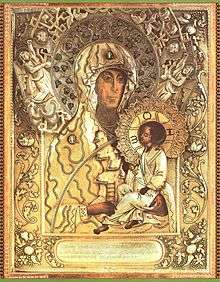

.jpg)
.jpg)

